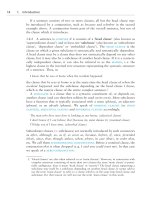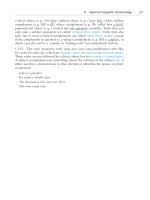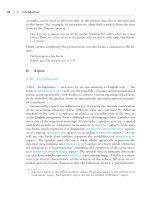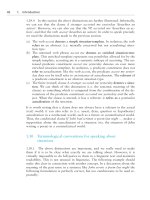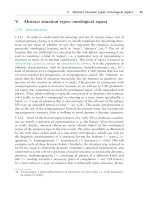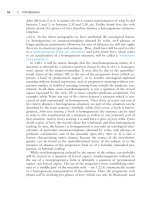The grammar of the english verb phrase part 11 doc
Bạn đang xem bản rút gọn của tài liệu. Xem và tải ngay bản đầy đủ của tài liệu tại đây (75.8 KB, 7 trang )
V. Abstract situation types: ontological aspect 63
?
It will take Bill a long time to read books. (atelic verb phrase) (If acceptable, the
sentence can only be interpreted as ‘It will last a long time before Bill starts reading
books’. There is no reading in which the duration of the situation of reading books
itself is measured.)
1.39.8 We have already stressed that (a)telicity is not a characteristic of sen-
tences (since the nature of the subject does not play a part in making the
distinction)
20
but of verbs and verb phrases. In fact, various constituents of the
verb phrase can determine the (a)telic nature of the situation-template. For
example, walk is an atelic verb, but walk a mile and walk for two hours are
telic situation-templates. In the latter examples, the ‘
telicizing’ constituents
(a mile, for two hours) ‘measure’ the length of the conceptualized type of situa-
tion. Measuring the duration of a situation naturally means considering it from
beginning to end. A verb phrase involving a measure phrase therefore naturally
represents a kind of situation as having a point of completion, i. e. as telic. (At
least, this is the case as long as there is no reference to actualization, i. e. as
long as the VP is used in isolation, as an infinitival form, and not as the
inflected VP of a tensed clause Ϫ see below). In write a book, the ‘
telos’
(point of completion) is implied rather than indicated by a phrase with a defi-
nite meaning, but there is measuring in the sense that a book is typically con-
ceived of as having an end and as constituting a unit of writing. In this case the
idea of a ‘telos’ is what Grice (1975) calls a ‘conventional’ (ϭ noncancellable)
pragmatic implicature of the infinitival VP write a book.
From a pragmatic point of view, there are only two kinds of verb phrase
that can measure a type of situation. One is exemplified by write a book or
build a wall, in which the point of completion is conventionally implicated,
but remains indefinite (i. e. writing a book and building a wall take up a spe-
cific amount of time, but the precise duration differs according to the length
of the book or the size of the wall and is unspecified when the verb phrase
write a book or build a wall is used). The other kind of measuring VP consists
of verb phrases which specify the exact location of the point of completion in
time or space, as when we use a verb phrase like walk for two hours (which
involves an adverbial indicating a specific duration), walk a mile (which in-
volves an indication of specific distance) or go into the church (which involves
an adverbial specifying a goal that is reached).
If the speaker uses a telic VP in a clause referring to the present or future,
the point of completion is not yet reached at speech time. This means that
reference to the precise length (i. e. duration or distance) of the situation, as in
20. Not only in John walked but also in Three people walked the VP is atelic. It is irrelevant
to this whether the three people walked together or one after another. Since walk is
atelic, the situation of the third person walking has no inherent point of completion,
and so the cumulative hypersituation of three people walking cannot have an inherent
point of completion either.
64 1. Introduction
She is walking for two hours, is pragmatically only possible if the speaker
knows in advance what the length of the situation is going to be. This is a very
important point, which is often neglected because the vast majority of examples
adduced to illustrate claims in connection with (a)telicity are in the past tense.
A sentence in the past tense typically refers to a ‘bounded’ situation, more
particularly to a situation whose actualization terminated before the time of
speech. This is the case irrespective of whether the VP is telic (e. g. John went
to London on his birthday) or atelic (e. g. John was in London on his birthday).
Conclusions drawn from examples in the past tense therefore often concern
boundedness rather than telicity. To illustrate the (a)telic nature of a situation-
template it is therefore better to use the VP in a present tense sentence in the
progressive form. Examples with a telic VP like John is running two miles.[He
is nearly half-way now.]orJohn is running for 45 minutes.[He is nearly half-
way now.] are then only acceptable if the speaker knows in advance what the
length of the complete situation is going to be. Only in that case is it pragmati-
cally possible for him to use a telic VP specifying the precise length (i. e. dura-
tion or distance) of the conceptualized kind of situation (whose actualization
is represented as still incomplete).
On a higher level than the VP, viz. on the level of the clause (which refers
to actualization), the indication of the full length of a situation can also be the
result of measuring the situation when the endpoint of the actualization is
reached, as in He had walked for two hours [before he reached the village].
However, what is measured here is not a kind of situation but a particular
instance of actualization. As we will see in section 1.48.2, when an adverbial
like for two hours is the result of this kind of measuring, it renders the clause
(and the actualizing situation referred to) bounded, but it does not affect the
atelic nature of the kind of situation denoted by the VP (walked). In other
words, for two hours is then a ‘bounding’ constituent, but not a telicizing one.
A measure phrase is telicizing only if it indicates the pre-determined length of
a kind of situation. In that case the speaker is able to indicate that length
because he knows in advance what it is going to be, as in the following:
John will walk a mile tomorrow.
John was walking a mile when he had a heart attack.
John was walking for two hours when he had a heart attack.
In these examples a mile and for two hours indicate the natural terminal point
of a pre-determined telic situation type: the description of the kind of situation
is not walk (which is atelic) but walk a mile or walk for two hours.
V. Abstract situation types: ontological aspect 65
1.40 Ontological feature 7: [( evolving]
1.40.1 A verb phrase may or may not represent a type of situation as evolv-
ing
, i. e. as gradually developing. Compare:
John drew a circle. (The situation is represented as dynamic, agentive and telic, but
not as evolving.)
The situation deteriorated. (dynamic, nonagentive, atelic, and evolving)
Evolving situations (e. g. growing, getting dark, diminishing) are always (con-
ceived of as) dynamic, durative, nonagentive and consisting in a gradual
change. The latter feature means that each stage of an evolving situation is
similar to the preceding stage, except that it usually represents a higher or
lower value on a scale. Prototypical verbs denoting an evolving situation are
change and develop (in their intransitive use, i. e. when they are nonagentive).
They imply movement on an implicit scale.
1.40.2 Punctual situations are by definition not evolving, because any evolu-
tion takes time. States are not evolving either, because an evolution involves
change, while states are by definition unchanging throughout their duration.
1.40.3 In section 1.33.1 it was noted that grammatical aspect can sometimes
overrule ontological aspect. We saw that John was writing two letters is homo-
geneous, although John wrote two letters is not. In the same way, the pro-
gressive form can sometimes change [Ϫ evolving] into [ϩ evolving]. Compare
John died, which represents a situation that is a punctual transition (and hence
not evolving) with John was dying, which represents the situation as evolving,
i. e. as nonstatic, nonagentive and gradually developing.
66 1. Introduction
VI. Classifications of situation types
1.41 Introduction
On the basis of the ontological features identified in section 1.33Ϫ40 various
types of situation-templates can be discerned. These ontological features can
also be used to distinguish the various abstract situation types referred to by
the linguistic expressions (verbs, VPs and predicate constituents) denoting these
situation-templates. Moreover, we can also apply the ontological features to
concrete actualizations of situations (and to the linguistic expressions Ϫ i. e.
clauses Ϫ referring to them). This is because the actualization of a situation is
referred to by a clause, which consists of a subject and a predicate constituent.
As we have seen, the subject can help to determine some of the ontological
features, e. g. (non)homogeneity Ϫ see 1.36.4 Ϫ or durativity Ϫ see 1.37.2.
Otherwise the ontological features necessary to distinguish between the types of
situation are determined by elements in the predicate constituent. It is therefore
perfectly possible to build a classification of situation types on the basis of the
ontological features distinguished in sections 1.33Ϫ40 under the heading of
‘ontological aspect’.
Apart from the fact that each ontological distinction (e. g. ‘static’ versus
‘dynamic’) by itself divides all situations into two types, there are two well-
known typologies which are based on more than one ontological distinction.
One is Lyons’ (1977) classification of situations into ‘states’, ‘actions’, ‘pro-
cesses’ and ‘events’; the other is Vendler’s (1967) classification of situations
into ‘states’, ‘activities’, ‘accomplishments’ and ‘achievements’. In the following
subsections we will briefly examine these two classifications.
1.42 Classification 1: states, actions, events and processes
In this section we introduce a categorization of situation kinds which reflects
our intuitive distinction between different kinds of actualization (determined
by the choice of verb, verb phrase, predicate constituent and subject of the
clause). The division in question is that between ‘states’, ‘actions’, ‘processes’
and ‘events’ Ϫ a fourfold distinction proposed by Lyons (1977). The conclusion
of the discussion will be that this is an extremely useful classification, provided
we slightly adapt some of Lyons’s definitions Ϫ see 1.42.5.
1.42.1 A
state (static situation) is a kind of situation which is conceived
of as existing (rather than as being done, taking place or developing) and as
homogeneous (because unchanging) throughout its duration. A state is not
agentive (i. e. when there is actualization, it is not performed or instigated by
VI. Classifications of situation types 67
an agent Ϫ see section 1.35 above) and is not conceived of as needing a con-
tinuous input of energy to continue.
1.42.2 Situations that are not static are called
nonstatic or dynamic. A dy-
namic situation may be (conceived of as) either punctual (e. g. knocking) or
durative (e. g. building something). In the latter case, the dynamic situation is
conceptualized as consisting of a number of stages (‘slices’), each of which may
be different from (though possibly of the same kind as) the previous stage. This
means that durative dynamic situations involve change and therefore as a rule
require a continuous input of fresh energy in order to continue.
Bill was a teacher. (static)
I need more money. Everything costs so much. (static situations)
I believe he is right. (static situations)
John walked in the wood this morning. (dynamic: the situation is conceived of as
made up of a number of temporal stages which are similar to each other but are
essentially different: at every new stage John has moved a bit forward and his body
is in a slightly different position.)
Bill will write a novel. (Writing a novel is a dynamic situation.)
1.42.3 Within the class of nonstatic (dynamic) situations, we will distinguish
between actions, events and processes.
Actions differ from the latter two situa-
tion types in that they actualize under the control of an agent (e. g. John dug
a hole), whereas the latter do not (e. g. John fell off the ladder; The population
diminished rapidly). An
event is a dynamic kind of situation which is not
controlled by an agent but just happens (e. g. bursting, exploding, falling off a
ladder, snowing). As is clear from these examples, an event may be (conceived
of as) punctual or durative. A
process (e. g. changing, getting dark, diminish-
ing) is also dynamic and nonagentive, but is always (conceived of as) durative
and involving incremental change that implies a scale of some sort. This means
that each stage of a process is similar to the preceding stage, except that it
usually represents a higher or lower value on a scale. While prototypical pro-
cess verbs like change or develop just imply movement on an implicit scale,
process verbs like increase or decrease emphasize that the subsequent stages of
the process correspond with different quantificational values on the scale, each
value being placed just above or below the value of the preceding stage.
21
1.42.4 Certain verbs can only be used with reference to a dynamic (nonstatic)
kind of situation (i. e. an action, event or process), unless they are used in a
21. In the (especially philosophically or logically oriented) linguistic literature the term pro-
cess is sometimes used in a different sense, viz. in the sense of our cover-term ‘situation’.
A sentence like John is walking is then considered as a process (rather than as an action
in progress). We will not follow this convention.
68 1. Introduction
sentence that receives a habitual interpretation.
22
Such verbs are commonly
called ‘dynamic verbs’. However, we will stick to the convention introduced in
1.37.2 (in connection with punctual / durative) and speak of ‘dynamic situation
verbs’ and ‘dynamic situation verb phrases’, which are more consistent and
more transparent terms than ‘dynamic verbs’ and ‘dynamic verb phrases’.
Verbs which in their default meaning (i. e. without habitual meaning and
without being put in the progressive form) refer to a process, action or event
will be called
process verbs, action verbs and event verbs, respectively. The
following are some illustrations:
(process verbs) change, grow, mature, die, widen, slow down, improve, thicken,
deteriorate, strengthen, diminish, darken, deepen, develop, increase
(action verbs) walk, read, drink, look at, write, eat, abandon, ask, play
(event verbs) explode, burst, take place, rain, occur, happen, break down, snow, be-
fall
1.42.5 The above classification is based on the ontological features [( static],
[( evolving] and [( agentive]. A
state is a static situation (see section 1.34.1).
An
action is an agentive dynamic situation (e. g. digging a hole); an event is
a nonagentive nonevolving dynamic situation (e. g. falling off a ladder); a
pro-
cess
is a nonagentive evolving dynamic situation (e. g. becoming dark). This
means that this ontologically based classification can be represented by the
following chart:
static evolving agentive
state ϩϪϪ
action ϪϪϩ
process ϪϩϪ
event ϪϪϪ
In this chart all the relevant distinctive features are referred to. Other ontologi-
cal features need not be mentioned because they either follow from the three
that are exploited or do not help to clarify the classification. Thus, it is not
useful to mark the four situation types for the distinctions (a)telic and (non)ho-
mogeneous because (a) all states are atelic and homogeneous, and (b) all three
nonstatic situation types may or may not be telic or homogeneous. Similarly,
it is superfluous to refer to the feature [( transitional], since states and pro-
cesses are always nontransitional, whereas actions and events may or may not
be transitional. (As noted in 1.38.1, a situation is transitional if it consists in a
single transition, conceived of as punctual, from one state into another.) And
22. In section 1.23.3 we have argued that a habit is a kind of characteristic, and hence a state.
VI. Classifications of situation types 69
it would also be redundant to refer to the feature [( durative], since states and
processes are always durative, whereas actions and events may or may not be.
In sum, the only features that are relevant are those that set off one situation
type from all the others, i. e. those for which only one situation type is marked
as [ϩ feature]. Thus, only states are [ϩ static], only processes are [ϩ evolving]
and only actions are [ϩ agentive].
23
It is also important to keep in mind that this classification is exclusively
based on ontological features. As we will see in 1.49.1, progressive aspect can
overrule the classification (e. g. whereas I am always careful denotes a state, I
am being careful denotes an action), but [( progressive] is not an ontological
feature and is therefore immaterial to the ontological classification.
1.42.6 The four types of situation distinguished in the preceding sections are
the same as those distinguished by Lyons (1977). However, the definitions differ
in a number of ways. Firstly, Lyons does not mention the feature [( evolving].
Secondly, whereas Lyons seems to allow for agentive processes and agentive
events (referring to agentive processes as ‘activities’ and agentive events as
‘acts’) we shall assume that all agentive dynamic situations are actions, and
that processes and events are always nonagentive. This adaptation is necessary
to clarify Lyons’ distinctions, which are not clearly defined in his text. Lyons’
(1977: 483) account says: “If a dynamic situation is extended in time, it is a
process; if it is momentary, it is an event; and, if it is under the control of an
agent, it is an action.” This suggests that the three dynamic situation types Ϫ
processes, events and actions Ϫ are mutually exclusive and that all dynamic
situations that are under the control of an agent are actions. (The inference
that the three are mutually exclusive is strengthened by the fact that Lyons
talks about “states on the one hand, and events, processes and actions on the
other” [p.483].) However, Lyons goes on to talk of agentive processes (which
are ‘activities’) and agentive events (‘acts’), which makes it clear that, if all
agentive situations are actions, then the three types of situation cannot be mu-
tually exclusive, and that some actions are processes and some actions are
events. This, though, prompts the question: what do we mean when we say
that a situation is a process or an event? If a process is agentive, it is an activity,
so when we say merely ‘process’, do we mean only a nonagentive process?
But then what is the point of having the term ‘process’ include agentive and
nonagentive situations if it is only ever interpreted as referring to nonagentive
situations? Because of the puzzling nature of this categorization, we have sim-
ply borrowed from Lyons what we believe to be the essential distinctions that
23. Of course, the border-line between these situation types is sometimes rather fuzzy. In Sit
still! the situation referred to is arguably both static and agentive. However, it remains
a fact that the chart correctly denotes the features which distinguish between prototypi-
cal states, actions, processes and events.



